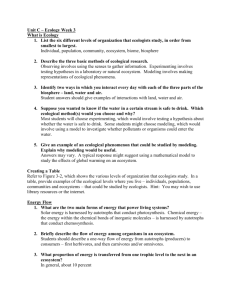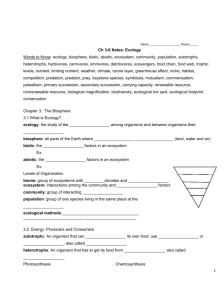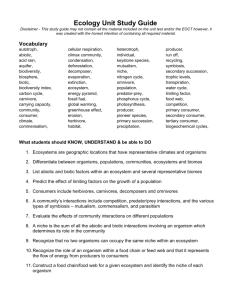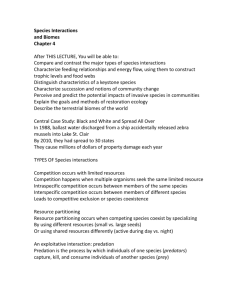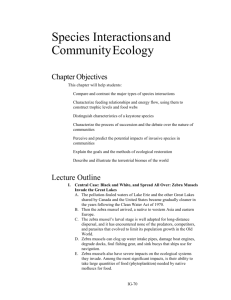Ecology Unit readings
advertisement
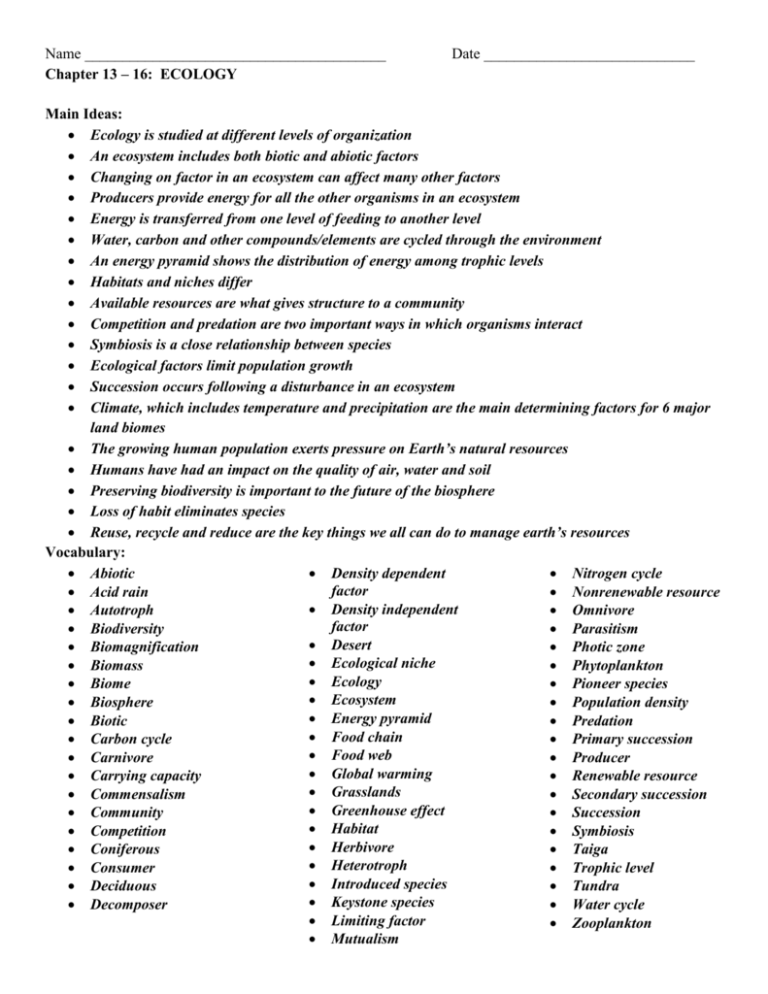
Name ________________________________________ Chapter 13 – 16: ECOLOGY Date ____________________________ Main Ideas: Ecology is studied at different levels of organization An ecosystem includes both biotic and abiotic factors Changing on factor in an ecosystem can affect many other factors Producers provide energy for all the other organisms in an ecosystem Energy is transferred from one level of feeding to another level Water, carbon and other compounds/elements are cycled through the environment An energy pyramid shows the distribution of energy among trophic levels Habitats and niches differ Available resources are what gives structure to a community Competition and predation are two important ways in which organisms interact Symbiosis is a close relationship between species Ecological factors limit population growth Succession occurs following a disturbance in an ecosystem Climate, which includes temperature and precipitation are the main determining factors for 6 major land biomes The growing human population exerts pressure on Earth’s natural resources Humans have had an impact on the quality of air, water and soil Preserving biodiversity is important to the future of the biosphere Loss of habit eliminates species Reuse, recycle and reduce are the key things we all can do to manage earth’s resources Vocabulary: Abiotic Density dependent Nitrogen cycle factor Acid rain Nonrenewable resource Density independent Autotroph Omnivore factor Biodiversity Parasitism Desert Biomagnification Photic zone Ecological niche Biomass Phytoplankton Ecology Biome Pioneer species Ecosystem Biosphere Population density Energy pyramid Biotic Predation Food chain Carbon cycle Primary succession Food web Carnivore Producer Global warming Carrying capacity Renewable resource Grasslands Commensalism Secondary succession Greenhouse effect Community Succession Habitat Competition Symbiosis Herbivore Coniferous Taiga Heterotroph Consumer Trophic level Introduced species Deciduous Tundra Keystone species Decomposer Water cycle Limiting factor Zooplankton Mutualism Chapter 14: Principles of Ecology 1. Label the diagram below showing the levels of organization of the biosphere. 2. Fill in the boxes to indicate whether the factor shown is abiotic or biotic. 3. What would happen if a keystone species such as a beaver were to be illuminated from an ecosystem? 4. Label the ecological food pyramid shown below with the terms: Producer, consumer, autotroph of heterotroph. 5. Pictured below are three different food chains. Label each organism as either: Producer, primary consumer, secondary consumer or top consumer. 6. Which type of organism will end up getting the energy from all of the organisms shown? 7. What is being illustrated below? _____________________ 8. Identify each of the following using the illustration from above. a. Producers: ______________ _________________ b. Primary consumers: __________ ________ ________ ________ ________ ___________ c. Secondary consumers: ________ _________ ______________ ____________ ___________ d. Top level consumers: ___________ ____________ 9. Below is an illustration of the Water cycle. Label the main parts of this cycle with the terms: precipitation, condensation, runoff, transpiration or evaporation. 10. Below is an illustration of the Carbon/Oxygen cycle. Label the parts of this cycle with the terms: Photosynthesis, respiration, carbon dioxide or oxygen. 11. Observe the energy pyramid shown below. Which trophic level will contain the most collect energy ____________________and which will have the least amount of collective energy stored in it? ______________________ 12. How is energy lost at each trophic level? Think of a word you learned at the start of the school year when we discussed the characteristics of all living things. 13. What percent of energy is transferred from one trophic level to the next? (Look at the Kg) Chapter 15: Interactions in Ecosystems 14. What is the difference between an organism’s habitat and its niche? 15. Observe the graph below of a predator/prey relationship. a. What happens to the predator population as the population size of the prey increases? b. What happens when the predator population increases to the prey population? 16. Identify each of the illustrated symbiotic relationships as either: Mutualism, parasitism or commensalism. Also, indicate with the symbols +, - or 0, the relationship they have with each other _______________________ Symbols? _____ & _____ ____________________________ ______ & ______ _____________________________ ______ & _______ 17. Examine the population growth curve of humans from 1800 – 1925 then answer the questions given below. a. When year did the population first reach carrying capacity? __________________ b. What is the carrying capacity for this population size? ______________ c. What is your prediction for population size immediately following WWII? 18. Identify each of the following as either density dependent or density independent factors. a. Competition between members of population. __________________________ b. Predation. ___________________________ c. A hurricane downing many earthworms ______________________ d. Disease _________________________ e. Burning of a forest ____________________________ f. A very cold winter ___________________ 19. To the diagrams below showing ecological succession in an ecosystem, label the pioneer species, the climax community and whether it is primary or secondary succession. Chapter 15: The Biosphere 20. Label the 6 main land biomes on the world map shown below 21. Name that biome!! Answer with the names of the biomes from above a. Cold and very little precipitation ___________________ b. Plenty of rainfall and evenly hot ____________________ c. Very little rainfall and hot days ___________________ d. 4 seasons with moderate precipitation and temperatures ____________________ e. Cooler temps with long winters and plenty of precipitation ________________________ f. Hot summers, cool winters and not a lot of precipitation ____________________ g. h. i. j. k. l. Contains many broadleaf trees like oaks and maples ______________________ Has basically confer trees like pines, spruces and fir trees __________________ A canopy of plants are all over & it is difficult to get through _______________ Bring on the ice sleighs!! __________________ Don’t forget your sunscreen here _____________________ Most of Canada __________________________ 22. Label the diagram below of the ocean zones using: abyssal, neritic, and intertidal zone. 23. What does the prefix “photo” mean? ____________________________ What would be able to penetrate down into the photic zone? ______________________________ 24. What zone would be loaded with phytoplankton? __________________________ 25. What zone would have organisms like the angler fish and the glowing jelly live in? Chapter 16: Human Impact of Ecosystems 26. Identify each of the following resources as either renewable or nonrenewable resources. 27. Look at figure 16.4 in your textbook on page 487. a. Which region shown has the largest ecological footprint? __________________ b. Which regions have the smallest footprints? __________________ & ______________ c. Which region has the largest population size? ______________________ 28. Discuss what causes acid rain and its effects on the environment. 29. Examine the graph showing the world’s temperature change through time. Compare the temperature to the amount of CO2. What has caused this major increase in global temperature? 30. DDT was a common pesticide used throughout the country for decades. DDT is stored in fat cells in animals. It has been responsible for drastic population decrease and near extinction of many animals such as the bald eagle, California condor and the peregrine falcon. It is not longer used today. Examine the diagram below and discuss what biomagnification of DDT hit the hardest on the birds of prey. 31. What does habitat destruction do to the biodiversity of an ecosystem? 32. Kudzu is an introduced species to the southern United States. What does an introduced species like kudzu or stink bugs do to the native populations?




